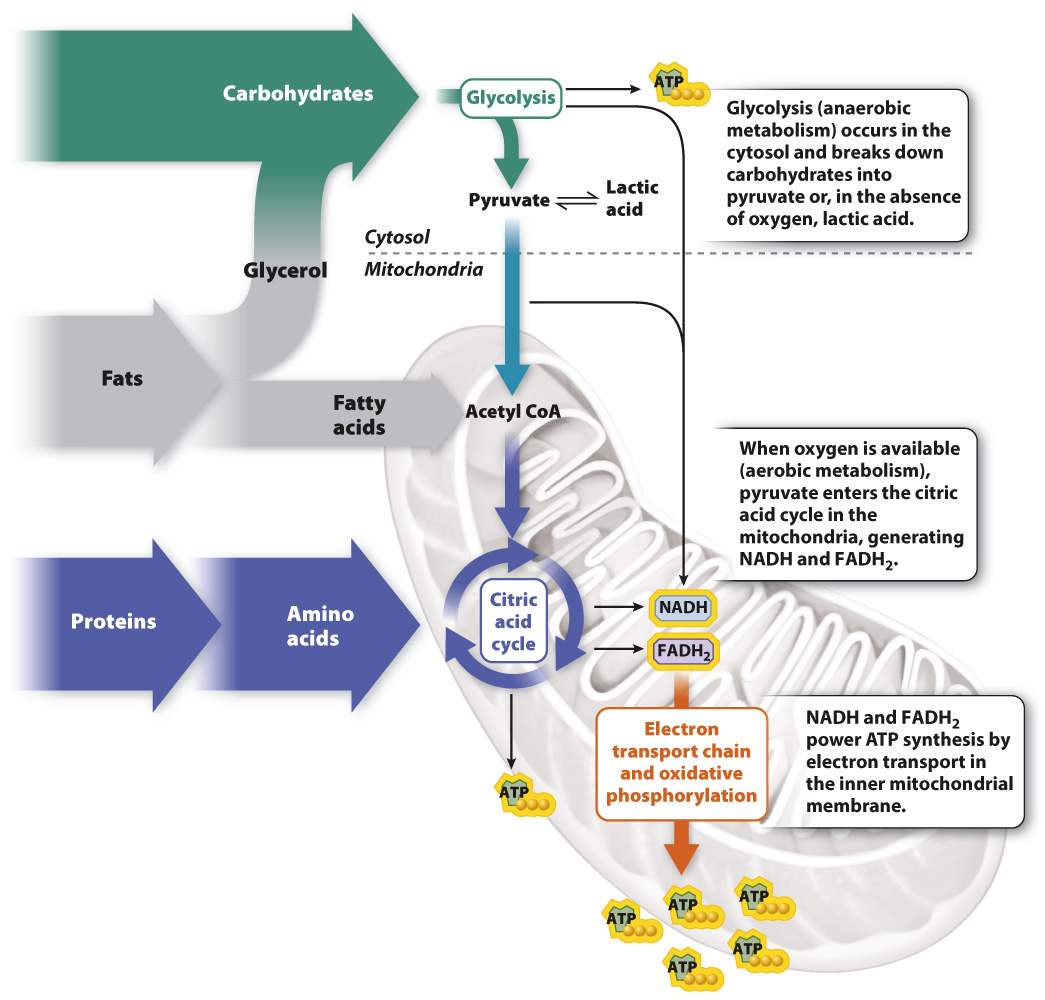Animals rely on anaerobic and aerobic metabolism.
Nearly all animals depend on three main classes of molecule as sources of energy and building blocks for growth and development: carbohydrates, fats, and proteins. These molecules are broken down, and in the process the energy in their chemical bonds is transferred to biologically useful forms, typically adenosine triphosphate (ATP). While other nucleic acid triphosphates also serve as usable forms of energy, ATP is by far the one most commonly used by animals. The breakdown of carbohydrates, fats, and proteins to produce ATP takes place through a series of chemical reactions. Reactions that break down food sources to fuel the energy needs of a cell are termed catabolic. In contrast, reactions that result in net energy storage within cells and the organism are anabolic.
Let’s first review the breakdown of carbohydrates, including sugars (such as glucose) and starches, food sources that are chemically similar but clearly different in taste and texture. Glucose can be partially broken down in the absence of oxygen by glycolysis (Fig. 40.1). Glycolysis occurs in the cytosol of the cell, and the breakdown of each glucose molecule results in the production of 2 molecules of pyruvate, 2 molecules of ATP, and 2 molecules of NADH. In animals, if oxygen is not present, or is present only in small amounts, pyruvate is converted by fermentation into lactic acid. The production of ATP by anaerobic (“absence of oxygen”) metabolism provides rapid but short-

In contrast, aerobic (“of oxygen”) metabolism (specifically, cellular respiration), carried out within the mitochondria of eukaryotic animals, provides a steady supply of ATP for longer-
Overall, aerobic respiration results in the formation of a total of 32 molecules of ATP when 1 molecule of glucose is broken down, much more than the 2 molecules of ATP from 1 molecule of glucose produced anaerobically. We can define metabolic efficiency as the amount of energy captured in a usable form (at least 234 kcal of useful ATP energy) per amount of energy in the starting molecule (686 kcal in 1 mol of glucose). The metabolic efficiency of aerobic respiration is therefore at least 34% (or 234/686 × 100). The remaining 66% of this energy is converted to heat and either lost to the environment or used to warm the animal. Glucose that is not metabolized is stored as glycogen, primarily in the liver and muscles.
Lipids are another important energy source for most animals. Lipids, such as triacylglycerol, consumed in the diet are broken down to glycerol and free fatty acids, which enter glycolysis or the citric acid cycle to yield ATP by oxidative phosphorylation (Chapter 7). Alternatively, they can be stored as fat (adipose tissue). Storing energy as fat is a particularly efficient way to store energy because it yields more than twice the energy supply per unit weight (9.4 kcal/g) as glycogen (4.2 kcal/g). Like lipids consumed in the diet, stored fats are also broken down into glycerol and free fatty acids, which yield ATP by the same pathways as lipids from the diet.
Proteins consumed in the diet can also be a useful energy source for animals. Carnivores such as cats get most of their energy from the protein in the meat they eat. Proteins, which are needed for building and maintaining the body, constitute the enzymes and structural elements of cells and tissues. Only following prolonged food deprivation, when fat and carbohydrate reserves are depleted, do animals break down protein reserves (mainly from their muscles) to form ATP. Animals preferentially rely on fats for long-
Quick Check 1 Muscle protein, fat, and glycogen are all reservoirs of energy. In what order are they used during a prolonged fast?
Quick Check 1 Answer
Glycogen stores are used first, and then fat, and finally muscle protein.